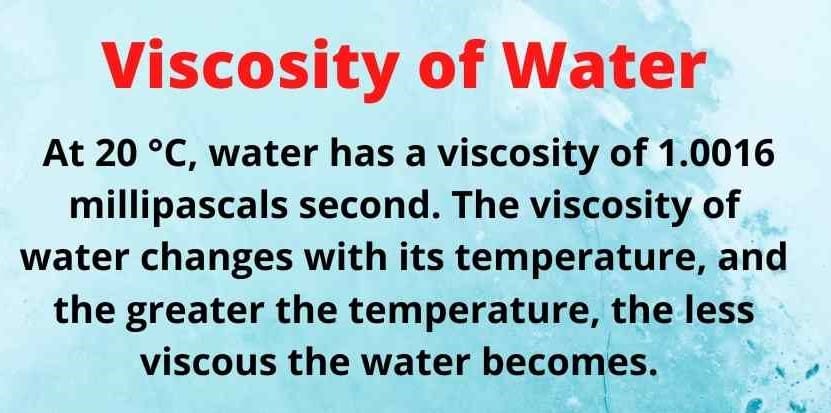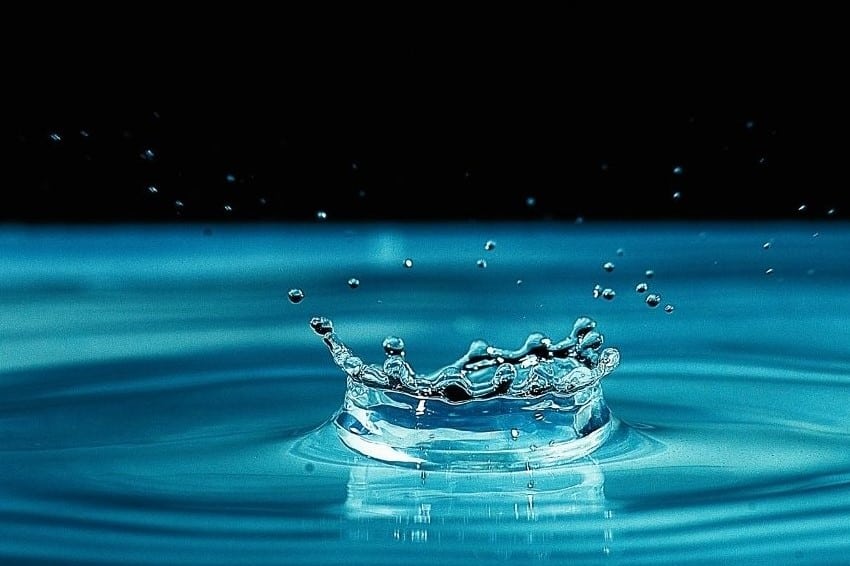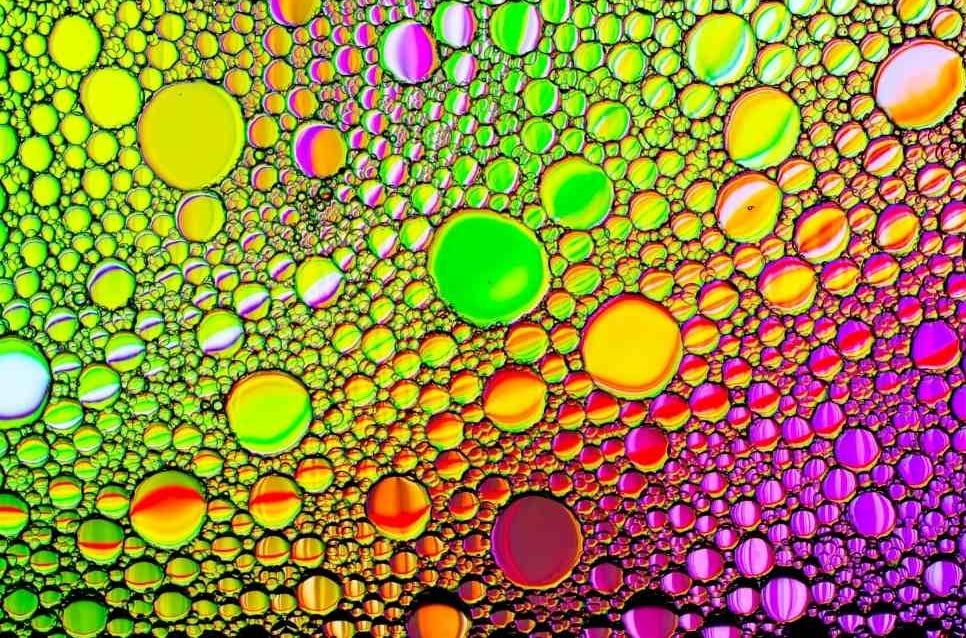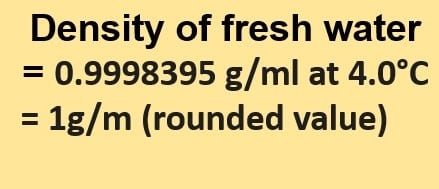The value of viscosity of water depends on the temperature and pressure of the water. At a temperature of 20 degrees Celsius (68 degrees Fahrenheit) and atmospheric pressure, the viscosity of water is approximately 0.001 Pa·s (Pascal seconds), or 0.001 kg/(m·s) in SI units. However, this value can change depending on the conditions under which the water is measured.
Viscosity is measured in the SI unit of Pascal seconds (Pa s). The dyne sec/cm2 is more commonly used and is referred to as Poise.
One Pascal second equals ten Poise.

Honey, oil, toothpaste, and some chemical elements like mercury are examples of high viscosity liquids.
The viscosity of water, for example, is low or “thin,” whereas honey has a “thick” or “high” viscosity. The viscosity law is useful in inkjet printing, protein formulations and injections, and even food and beverage production.
Water has a viscosity of 1.0016 millipascals second at 20 °C. The viscosity of water changes with its temperature, and the greater the temperature, the less viscous the water becomes.
The values of water’s dynamic viscosity at various temperature ranges are listed below.
| Temperature (in degrees Celsius) | Dynamic viscosity of water (in mPa.s) |
| 20 | 1.0016 |
| 30 | 0.7972 |
| 40 | 0.6527 |
| 50 | 0.5465 |
Table of Contents
Why Viscosity of Water?
| Reason | Explanation |
|---|---|
| Industrial processes | Knowledge about the viscosity of water is essential for optimizing fluid-handling equipment and manufacturing processes. |
| Fluid dynamics | Understanding the behavior of fluids is important in a variety of fields, and knowledge about the viscosity of water is used to model and predict the behavior of fluids in natural systems and to design structures. |
| Cooking and baking | The viscosity of water affects the texture and consistency of many foods and beverages, and knowledge about the viscosity of water is important for optimizing the texture of sauces and gravies, creating smooth and creamy desserts, and achieving the desired consistency in bread dough and other baked goods. |
| Health and medicine | The viscosity of water can affect the performance of medical devices and treatments, and knowledge about the viscosity of water is important for the design of medical equipment and the development of treatments for various conditions. |
Definition of Viscosity
A fluid’s (liquid or gas’s) viscosity is its resistance to shape change or movement of adjoining sections relative to one another. It explains the internal friction of a moving fluid. For example, honey spreads much slower than water because honey has a higher viscosity than water. Pascal seconds (Pa-s) are commonly used to quantify viscosity, a measurement of force equal to one kilogram per meter per second (kg/(ms)). The difference between low viscous and high viscous fluids is given in table below:
| Low Viscosity | High Viscosity |
|---|---|
| Flows easily | Flows slowly |
| Low resistance to deformation | High resistance to deformation |
| Low internal friction | High internal friction |
| Examples: tap water, distilled water | Examples: honey, syrup |
Kinematic Viscosity of Water
The kinematic viscosity of water at 20 °C is about 1 cSt.
The physical unit for kinematic viscosity is the stokes (St), named after George Stokes. It is sometimes expressed in terms of centistokes (cS or cSt); 1 stokes = 100 centistokes = 1 cm2 s−1 = 0.0001 m2 s−1.
The specific gravity of water
Specific gravity is defined as the ratio of a material’s density to that of water at 4 °C (where it is most dense and is taken to have a value of 999.974 kg m-3). As a result, it is a relative quantity with no units.
The specific gravity of water is 1 at 4 degrees Celsius.
Properties of Water
| 1 liter of water | 1000 grams, 35.274 ounces, or 0.264 US gallons |
| The specific gravity of water | The specific gravity of water is 1 at 4 degrees Celsius. Specific gravity is a ratio and has no units. |
| Unit weight of water (weight/volume) | 1 g/cm3 at 25 degrees Celsius |
| The melting point of water | 0.00 °C (32.00 °F; 273.15 K) |
| Specific heat of water | 4182 J/kg°C |
| Thermal conductivity of water | 0.591 W/m·K |
| Unit weight of water | 62.48 pounds |
What makes water a universal solvent?
Water is a universal solvent due to its polar hydrogen bonding, which allows it to dissolve a wide range of compounds. Because of the polarity of the bonds between the two hydrogen atoms and the oxygen atom, the molecule has slightly positive and slightly negative charges on both sides. Because of its charged sides, water is greatly attracted to the charged ends of other compounds, such as salt. This attraction destroys the other molecule by dissolving the attracting components that keep it together. This is why water dissolves a broad variety of chemicals. It is crucial to remember, however, that water does not dissolve everything; for example, oils do not dissolve well in water and instead precipitate on top of it.
Summary
- The viscosity of water at 20 degrees Celsius is 0.01 poise or 0.001 Pa.s (Pascal seconds).
- One Pascal second equals ten Poise.
- The resistance to fluid flow and the movement of an object through a fluid is usually expressed in terms of viscosity.
Recommended Video
Related Links
Boiling of Water| Phenomenon, and Factors Affecting
Surface Tension of Water
Soft Water vs. Hard Water
Cubic Foot of Water Weight
Weight of Water| Properties of Water
More Practice Questions
- What is viscosity?
Viscosity is a measure of a fluid’s resistance to flow. It describes how easily a fluid can be deformed, and how much force is required to move it.
- How is viscosity of water measured?
Viscosity of water can be measured using a viscometer, which is an instrument that measures the time it takes for a fluid to flow through a small tube orifice under the force of gravity. The viscosity of water is typically expressed in units of centipoise (cP) or millipascal-seconds (mPa.s).
- Why does the viscosity of water change with temperature?
The viscosity of water decreases as temperature increases. This is because higher temperatures cause water molecules to move more quickly, which reduces the cohesive forces between them and makes the water flow more easily.
- What factors affect the viscosity of water?
The viscosity of water is affected by factors such as temperature, pressure, and the presence of dissolved salts or other substances. For example, adding salt to water can increase its viscosity by increasing the strength of the hydrogen bonds between water molecules.
- What are some practical applications of knowledge about the viscosity of water?
Knowledge about the viscosity of water is used in a wide range of fields, including industrial processes, fluid dynamics, cooking and baking, and health and medicine. It is important for optimizing fluid-handling equipment and manufacturing processes, modeling and predicting the behavior of fluids in natural systems, achieving desired texture and consistency in food and beverages, and designing medical equipment and treatments.
More Related Questions
1. What is the viscosity of water at a temperature of 20° Celsius?
At 20 degrees Celsius, the viscosity of water is approximately 0.01 poise or 10-3 Pa.s (Pascal seconds). This number can also be expressed as 1.0016 mPa.s.
2. What is viscous flow?
The viscous fluid is defined as a fluid with a high flow resistance. The degree of resistance between the fluid layers is measured by viscosity, which is a fluid factor. Fluids that have no or minimal internal friction resistance are categorized as non-viscous fluids.
3. Laminar flow definition
Laminar flow is a form of fluid (gas or liquid) flow in which the fluid flows smoothly and in predictable patterns. In contrast, turbulent flow is a type of fluid in which the fluid fluctuates and mixes irregularly.
4. What is the SI unit of viscosity?
The unit of viscosity is newton-second per square meter, which is usually expressed as pascal-second in SI units.
5. Why does oil float on water?
Oil floats on water because its density is lower than that of water. Density in liquids is defined as the amount of mass that may be filled in a cubic meter of volume. Water has a density of roughly 1000 kg/cubic meter, while oil has a density ranging from 800 to 960 kg/cubic meter.
6. Is water a mixture?
Water is not a mixture. It is a pure hydrogen-oxygen compound. Simply put, hydrogen and oxygen react chemically to form a compound called water. Check the full article “is water a mixture?”.
7. How many cups in a gallon?
A US liquid gallon is equal to 16 cups, and a US dry gallon is equal to 18.61 cups. In the United States, one cup equals half a pint (236.6 ml).
To get a more detailed answer, click “how many cups in a gallon.”
8. What is the melting point of water?
The melting point of pure water ice at 1 atmosphere of pressure is very close to 0 °C, which is 32 °F or 273.15 K.
More Interesting Topics
- BCl3 Lewis Structure in four simple steps - November 1, 2023
- PH3 Lewis Structure in four simple steps - October 8, 2023
- PF3 Lewis structure in four simple steps - September 24, 2023




